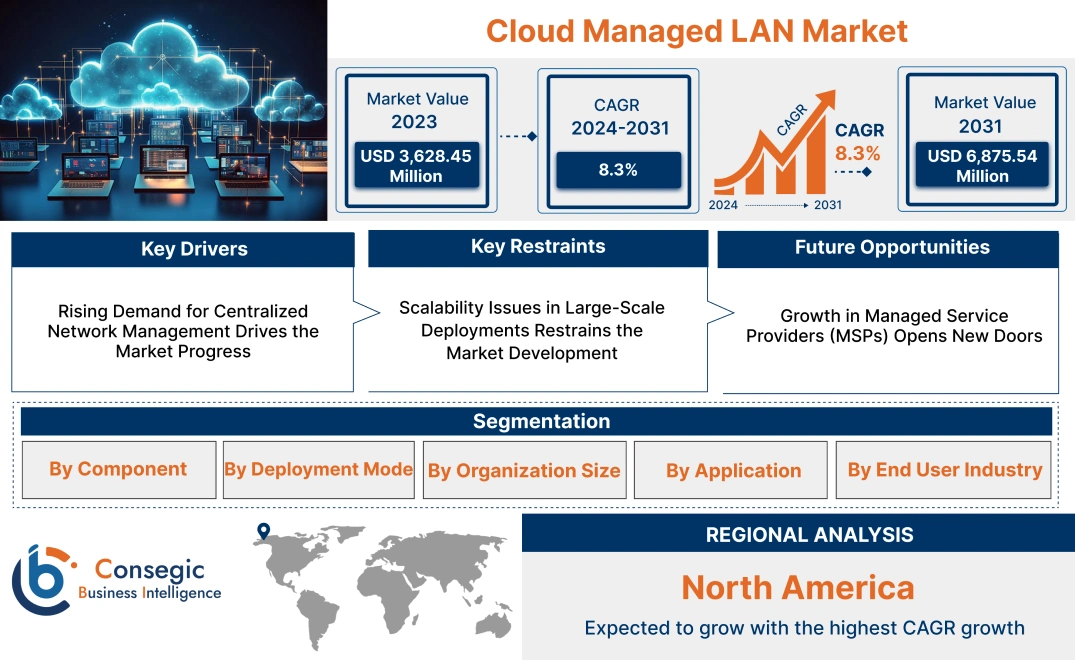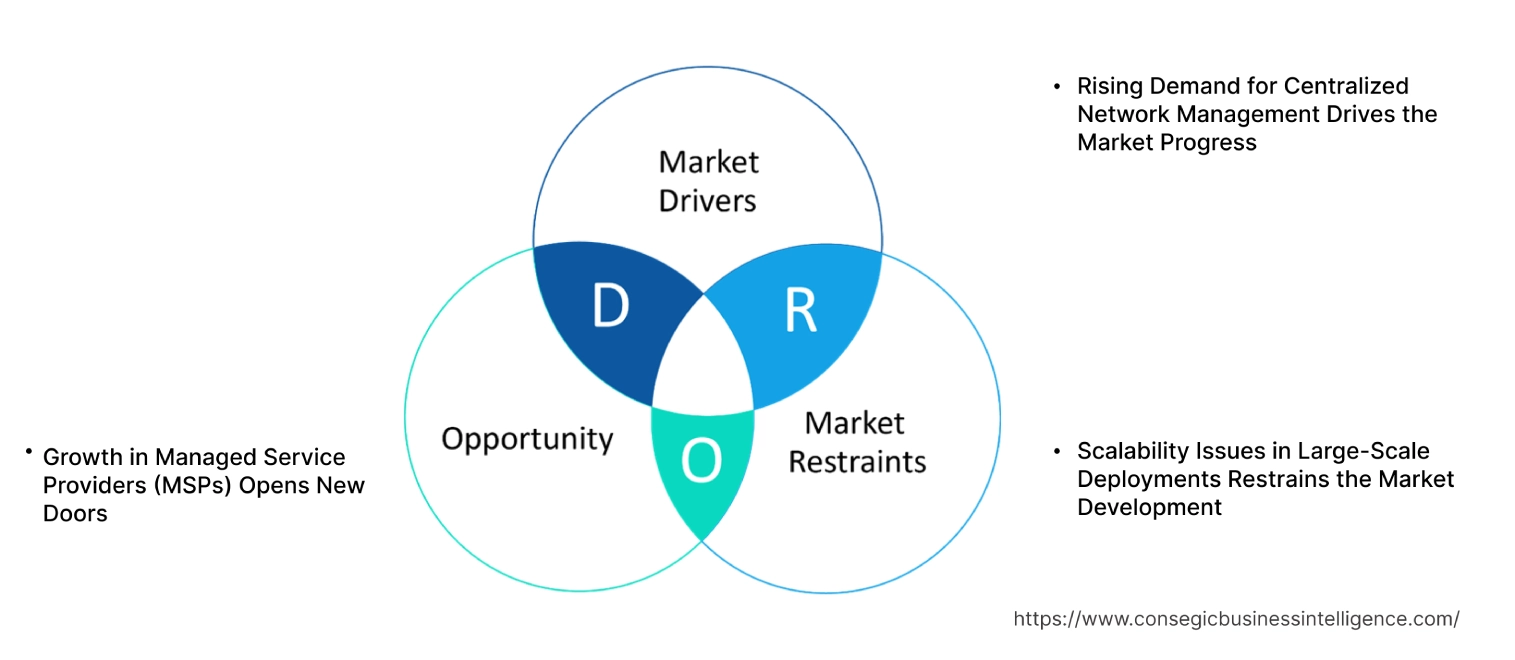Cloud Managed LAN Market Size:
Cloud Managed LAN Market Size is estimated to reach over USD 7.71 Billion by 2032 from a value of USD 3.87 Billion in 2024 and is projected to grow by USD 4.15 Billion in 2025, growing at a CAGR of 8.0% from 2025 to 2032.
Cloud Managed LAN Market Scope & Overview:
A cloud-managed LAN is a network solution where entire local network, including devices like switches and Wi-Fi access points, is controlled and monitored from a central cloud platform. This makes managing network simpler, reduces the need for on-site technical staff, and offers the flexibility to configure and oversee LAN remotely. Further, these solutions streamline network administration by providing real-time monitoring, automatic updates, and adaptable network configurations.
Cloud Managed LAN Market Dynamics - (DRO) :
Key Drivers:
Growing need for remote and centralized network management is driving the cloud managed LAN market expansion
Businesses typically run on increasingly intricate, multi-location networks, demanding simpler ways to control and monitor them. Cloud managed LAN solutions meet this need by offering centralized dashboards for real-time visibility, configuration, and troubleshooting. This leads to fewer operational difficulties and greater network scalability. Businesses can remotely manage and fine-tune their networks, ensuring smooth connectivity across their global operations.
With an increasing number of organizations adopting hybrid work models, there is a pressing need for LAN solutions that can be managed remotely. Cloud-managed LAN services facilitate centralized management, offering greater flexibility and control over network resources. This, in turn, reduces operational costs and enhances network performance, driving their adoption across various industries.
- For instance, in April 2025, HPE expanded HPE Aruba Networking Central, an AI-powered and security-focused network management solution. With this development, customers can have flexible deployment options, including dedicated virtual private clouds, on-premises installations, public SaaS, or a network as a service model.
Thus, according to the cloud managed LAN market analysis, the growing need for remote and centralized network management is driving the cloud managed LAN market size.
Key Restraints :
Security concerns are affecting the cloud managed LAN market demand
Despite the robust security features offered by cloud-based LAN solutions, organizations remain suspicious of potential data breaches and cyber threats. The increasing frequency of cyberattacks and the potential for data loss can hinder the widespread adoption of cloud solutions. Additionally, the high initial investment required for implementing these solutions may pose a challenge for some organizations, particularly SMEs with limited budgets. Therefore, according to the above analysis, these factors would further impact the cloud managed LAN market size.
Future Opportunities :
Increasing adoption of cloud computing and digital transformation initiatives across various sectors is expected to drive the cloud managed LAN market opportunities
The proliferation of IoT devices and the growing need for efficient network management solutions are creating a substantial need for cloud managed LAN services. Furthermore, the integration of AI and ML technologies in these solutions is enhancing their capabilities, offering predictive analytics and improved security features. These advancements are expected to drive the market development, while providing lucrative opportunities for stakeholders.
- For instance, in April 2024, IBM acquired HashiCorp to help businesses automate their hybrid and multi-cloud environments. This acquisition further demonstrates IBM's strong commitment and investment in hybrid cloud and artificial intelligence (AI) technologies.
Thus, based on the above cloud managed LAN market analysis, the increasing adoption of cloud computing and digital transformation initiatives across various sectors is expected to drive the cloud managed LAN market opportunities.
Cloud Managed LAN Market Segmental Analysis :
By Component:
Based on component, the market is segmented into hardware, software, and services.
Trends in the component:
- Cloud-based software platforms offer a broad range of features, including real-time monitoring, automated troubleshooting, and enhanced security measures. These features enable organizations to manage their LANs more efficiently and effectively, reducing downtime and enhancing overall network performance.
- The integration of AI and ML technologies in cloud-based solutions further enhances their capabilities, making them necessary for modern network management.
- Thus, the above factors are driving the cloud managed LAN market demand.
The hardware segment accounted for the largest revenue in the year 2024.
- In the hardware segment, the demand for advanced networking equipment is on the rise, driven by the need for high-performance, reliable, and scalable network infrastructure.
- Innovations in hardware, such as the development of smart switches and high-speed access points, are playing a crucial role in enhancing network performance and reliability.
- Moreover, the growing adoption of these advanced hardware solutions is expected to drive the hardware segment's development.
- Thus, based on the above analysis, these factors are further driving the cloud managed LAN market growth.
The services segment is anticipated to register the fastest CAGR during the forecast period.
- The services segment is also projected to experience significant development, driven by the increasing demand for professional and managed services.
- As organizations strive to optimize their network performance and reduce operational complexities, they are increasingly turning to professional service providers for consulting, integration, and support services.
- Managed services are gaining traction as they offer comprehensive LAN management solutions, allowing organizations to focus on their core business activities while ensuring optimal network performance.
- Thus, based on the above analysis, these trends are expected to drive the cloud managed LAN market share during the forecast period.
By Deployment Mode:
Based on deployment mode, the market is segmented into public cloud, private cloud, and hybrid cloud.
Trends in the deployment mode:
- The shift towards digital transformation across various industries, coupled with the rising adoption of cloud-native technologies, is propelling the segment's growth.
- The cloud's inherent flexibility allows businesses to dynamically allocate resources and scale operations up or down based on demand, in turn leading to significant cost savings.
The public cloud accounted for the largest revenue share of 57.45% in the year 2024.
- The increasing reliance on data analytics and artificial intelligence is driving organizations to invest in public cloud infrastructure.
- The cloud environment offers the computational power necessary to process large datasets and run complex AI models, enabling businesses to extract actionable insights and make data-driven decisions.
- The expansion of Internet of Things (IoT) technologies is generating vast amounts of data that require scalable storage and processing solutions, further boosting the demand for cloud infrastructure services.
- Thus, based on the above analysis, these factors would further supplement the cloud managed LAN market
The hybrid cloud segment is anticipated to register the fastest CAGR during the forecast period.
- The hybrid cloud model, which combines the best features of both public and private clouds, offers significant advantages such as better data control, enhanced security, and seamless integration, which are major growth factors for the market.
- By leveraging hybrid cloud environments, organizations can utilize the potential of these technologies to drive business growth and gain a competitive edge.
- Moreover, the growing emphasis on data security and compliance is also fueling the adoption of hybrid cloud services.
- The above factors are anticipated to further drive the cloud managed LAN market trends during the forecast period.
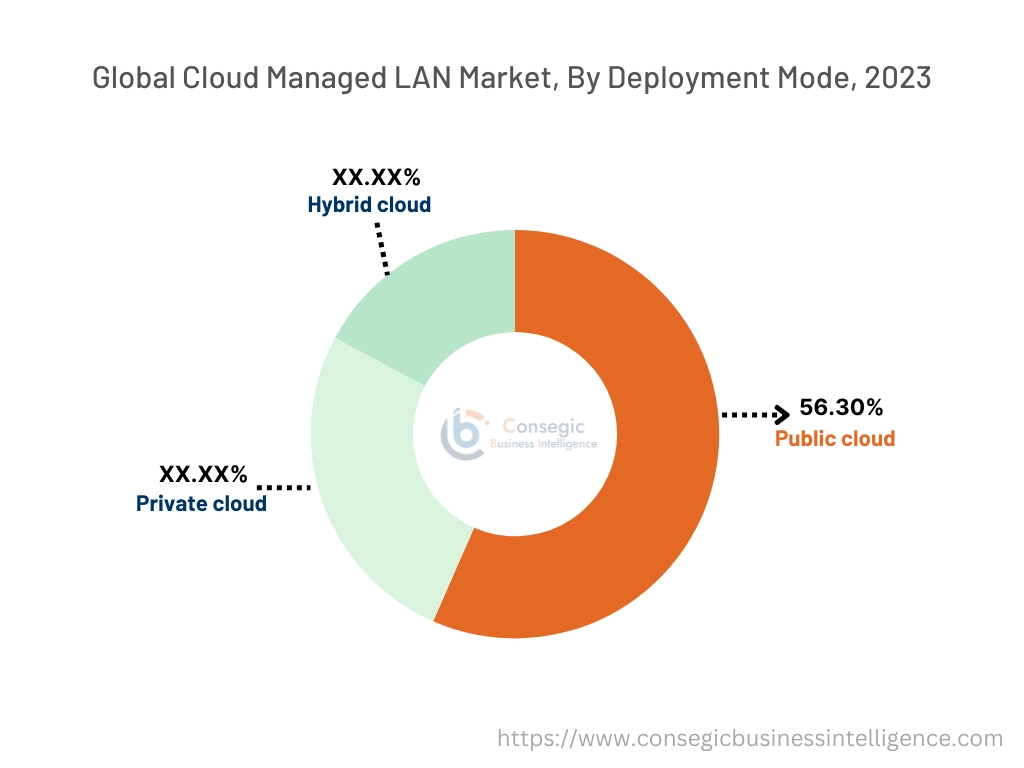
By Organization Size:
Based on organization size, the market is segmented into small & medium enterprises (SMEs) and large enterprises.
Trends in the organization size:
- Enterprises are increasingly implementing hybrid work models, necessitating robust and flexible network management solutions. Cloud services facilitate remote management, ensuring seamless connectivity and performance across distributed work environments.
- SMEs and large enterprises are recognizing the benefits of hybrid cloud solutions in terms of flexibility, scalability, and cost savings.
The large enterprises segment accounted for the largest revenue share in the year 2024.
- Large enterprises are adopting cloud managed LAN solutions to streamline their network management processes and enhance overall operational efficiency.
- These organizations typically have complex network infrastructures that require sophisticated management solutions.
- Moreover, cloud managed LAN services offer centralized management, real-time monitoring, and automated troubleshooting, enabling large enterprises to maintain optimal network performance and reduce downtime.
- Thus, based on the above analysis, these factors are driving the cloud managed LAN market growth.
The small & medium enterprises (SMEs) segment is anticipated to register the fastest CAGR during the forecast period.
- In small & medium enterprises (SMEs) segment, the primary driver for adoption of cloud managed LAN solutions includes its ability to access advanced network management features without the need for extensive in-house IT infrastructure.
- Cloud-based solutions provide a cost-effective alternative to traditional LAN management, enabling SMEs to leverage the latest technologies and maintain a competitive edge in their respective markets.
- Moreover, the growing awareness regarding these benefits is expected to drive the adoption of cloud managed LAN solutions among SMEs.
- Hence, the above factors are anticipated to further drive the cloud managed LAN market trends during the forecast period.
By Application:
Based on application, the cloud managed LAN market is segmented into network security, performance management, traffic management, cloud integration, and others.
Trends in the application:
- The rapid market growth can be attributed to the increasing adoption of cloud computing technologies, escalating cyber threats, and the need for robust security solutions.
- The increasing complexity of cyber threats, including ransomware, phishing, and advanced persistent threats (APTs), has prompted organizations to invest heavily in cloud network security solutions to safeguard their digital assets.
The network security segment accounted for the largest revenue in the year 2024.
- Business enterprises are increasingly recognizing the benefits of cloud computing, such as cost efficiency, scalability, and flexibility, which has led to a surge in cloud network security adoption.
- Moreover, the regulatory compliance and data protection laws are compelling organizations to adopt stringent security measures.
- Governments and regulatory bodies worldwide are implementing stringent data protection and privacy regulations, such as GDPR in Europe and CCPA in California, to protect consumer data and ensure its secure handling.
- Thus, the aforementioned factors are driving the network security segment, in turn propelling the global market.
The cloud integration segment is anticipated to register the fastest CAGR during the forecast period.
- Organizations are increasingly migrating their operations to the cloud to achieve enhanced flexibility, scalability, and cost-efficiency. This transition necessitates the integration of various cloud and on-premises systems, thereby fuelling the need for cloud integration services.
- The proliferation of data generated from diverse sources such as IoT devices, social media, and enterprise applications further emphasizes the need for robust cloud integration solutions that can seamlessly manage and unify this disparate data.
- Additionally, organizations across the globe are embracing digital technologies to streamline their operations, enhance customer experiences, and gain a competitive edge. Cloud integration plays a pivotal role in these transformation efforts by enabling the seamless flow of data and applications across various platforms and systems.
- These factors are anticipated to further drive the global market during the forecast period.
By End-User Industry:
Based on end user, the cloud managed LAN market is segmented into IT & telecom, BFSI, healthcare, education, retail, government & public sector, and others.
Trends in the end user:
- Retailers are increasingly adopting these solutions to manage their networks efficiently, ensuring seamless connectivity across their stores and optimizing customer experiences. The integration of cloud-based LAN solutions with advanced analytics tools also enables retailers to gain valuable insights into customer behaviors and preferences.
- Cloud-based LAN solutions offer scalability and reliability, making them ideal for healthcare organizations intending to enhance their network performance and support their digital transformation initiatives.
The IT & telecom accounted for the largest revenue share in the year 2024 and it is expected to register the highest CAGR during the forecast period.
- The IT and telecommunications sector, being at the forefront of technological advancements, is a major adopter of cloud-based solutions.
- These solutions provide the flexibility and scalability required to support the dynamic and complex network environments in this sector.
- In addition, the increasing need for high-speed internet and the development of 5G networks are further driving the adoption of cloud-based LAN management solutions in IT and telecommunications.
- Thus, the aforementioned factors are further driving the global market.
Regional Analysis:
The global market has been classified by region into North America, Europe, Asia-Pacific, Middle East & Africa, and Latin America.
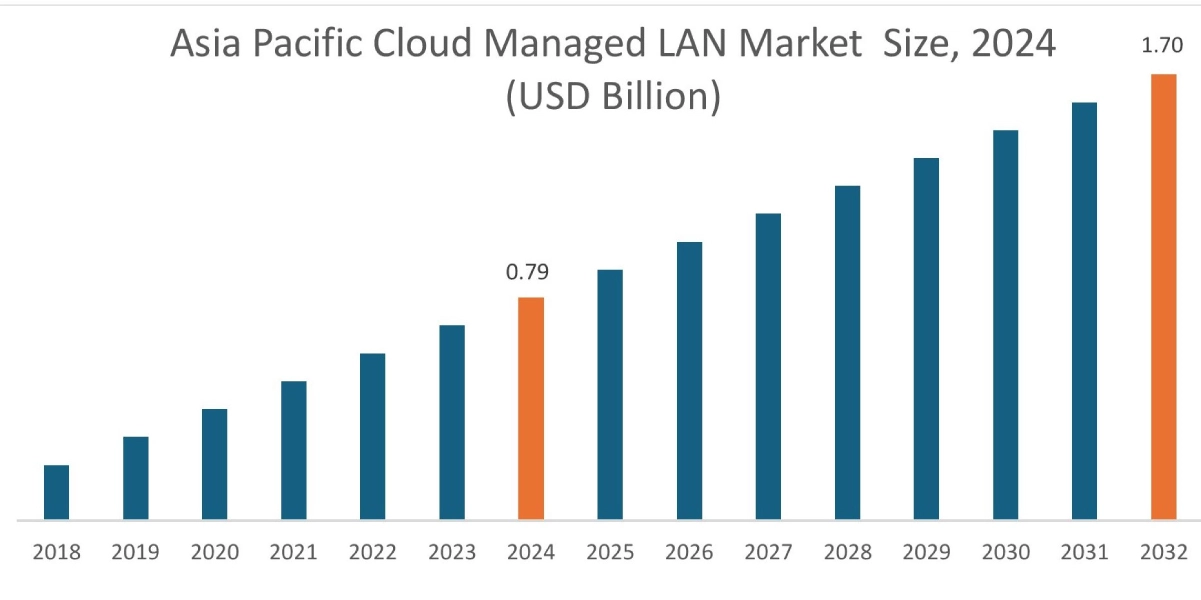
Asia Pacific cloud managed LAN market expansion is estimated to reach over USD 1.70 billion by 2032 from a value of USD 0.79 billion in 2024 and is projected to grow by USD 0.86 billion in 2025. Out of this, the China market accounted for the maximum revenue split of 35.45%. The regional growth can be attributed to the rapid digital transformation initiatives in countries such as China, India, and Japan among others. The increasing investments in IT infrastructure, coupled with the growing number of SMEs, are driving the need for cloud-managed LAN solutions in this region. Additionally, the rising adoption of IoT devices and development of high-speed internet networks are further propelling the regional market growth. These factors would further drive the regional cloud managed LAN market during the forecast period.
- For instance, in September 2024, Airtel Business announced partnership with Cisco to launch Airtel Software-Defined (SD) Branch. This new offering is a comprehensive, cloud-based managed network solution designed for businesses. It is powered by the Cisco Meraki platform and provides unified management of WAN, security, and LAN, and connectivity across various branch locations, making network operations simpler and improving application performance.
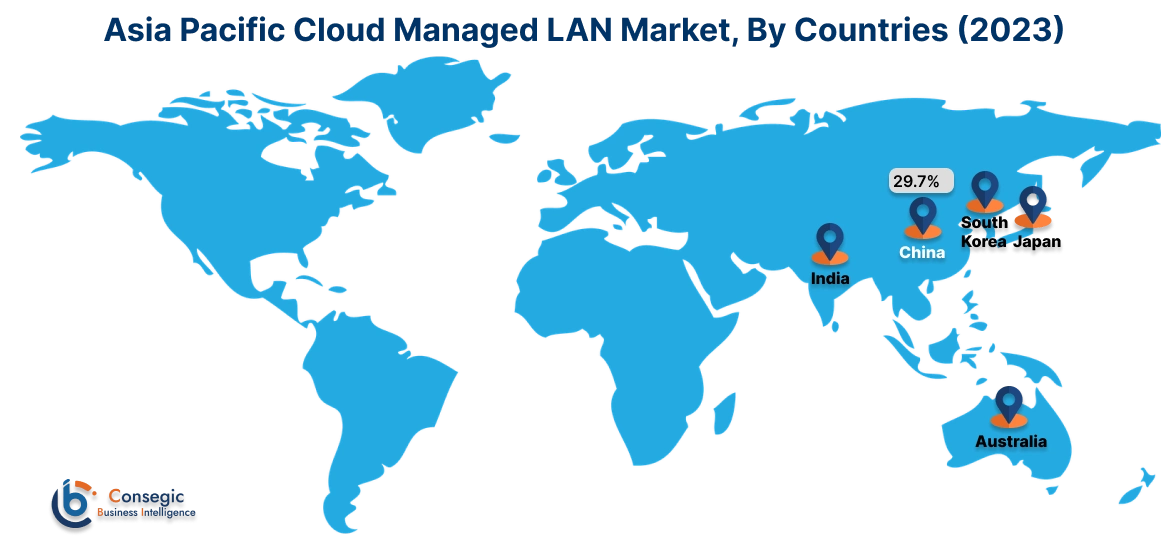
North America market is estimated to reach over USD 3.24 billion by 2032 from a value of USD 1.64 billion in 2024 and is projected to grow by USD 1.75 billion in 2025. This region holds a substantial share in the global market, driven by the rising adoption of advanced technologies and the presence of key industry leaders. The United States has widely adopted cloud-managed LAN solutions across diverse industry verticals, including information technology, telecommunications, and healthcare. The increasing integration of cloud computing with LAN infrastructure has empowered organizations to significantly boost network scalability and operational efficiency. These factors would further boost the cloud managed LAN market in North America.
Additionally, according to the analysis, the cloud managed LAN industry in Europe is projected to witness significant development during the forecast period. The region's strong emphasis on data security and regulatory compliance is leading to the implementation of advanced network management solutions. Additionally, Latin American enterprises are increasingly embracing digital transformation initiatives to enhance competitiveness, streamline operations, and meet evolving customer needs. Further, several Middle East & African countries, particularly in the GCC, are striving to diversify away from oil dependence. Rising digital transformation and increasing adoption of advanced technologies, including cloud-managed networks, are central to building knowledge-based economies and fostering new industries in the region.
Top Key Players and Market Share Insights:
The global cloud managed LAN market is highly competitive with major players providing solutions and services to the national and international markets. Key players are adopting several strategies in research and development (R&D), product innovation, and end-user launches to hold a strong position in the market. Key players in the cloud managed LAN industry include-
- Cisco Systems, Inc. (USA)
- Aruba Networks (USA)
- Ubiquiti Inc. (USA)
- Cambium Networks (USA)
- NETGEAR, Inc. (USA)
- Ruckus Networks (USA)
- Huawei Technologies Co., Ltd. (China)
- ZTE Corporation (China)
- Nokia Corporation (Finland)
- Extreme Networks, Inc. (USA)
Recent Industry Developments :
Product Launch:
- In October 2024, CommScope launched the RUCKUS Edge platform, a new cloud-managed service that expands the capabilities of its existing AI-powered RUCKUS One platform directly to the network edge. This innovation enables rapid deployment and simplified management of various services and applications. It achieves this by combining cloud-based orchestration with an edge appliance, which serves as the local delivery point for these services.
Cloud Managed LAN Market Report Insights :
| Report Attributes | Report Details |
| Study Timeline | 2019-2032 |
| Market Size in 2032 | USD 7.71 Billion |
| CAGR (2025-2032) | 8.0% |
| By Component |
|
| By Deployment Mode |
|
| By Organization Size |
|
| By Application |
|
| By End-User Industry |
|
| By Region |
|
| Key Players |
|
| North America | U.S. Canada Mexico |
| Europe | U.K. Germany France Spain Italy Russia Benelux Rest of Europe |
| APAC | China South Korea Japan India Australia ASEAN Rest of Asia-Pacific |
| Middle East and Africa | GCC Turkey South Africa Rest of MEA |
| LATAM | Brazil Argentina Chile Rest of LATAM |
| Report Coverage |
|
Key Questions Answered in the Report
How big is the Cloud Managed LAN Market? +
Cloud Managed LAN Market size is estimated to reach over USD 6,875.54 Million by 2031 from a value of USD 3,628.45 Million in 2023 and is projected to grow by USD 3,865.61 Million in 2024, growing at a CAGR of 8.3% from 2024 to 2031.
What specific segmentation details are covered in the Cloud Managed LAN Market report? +
The Cloud Managed LAN Market report covers segmentation based on component (hardware, software, and services), deployment mode (public cloud, private cloud, hybrid cloud), organization size (SMEs and large enterprises), application (network security, performance management, traffic management, cloud integration, others), and end-user industry (IT & telecom, BFSI, healthcare, education, retail, government & public sector, others).
Which is the fastest-growing segment in the Cloud Managed LAN Market? +
The services segment is expected to register the fastest CAGR during the forecast period. This includes consulting, integration, and support & maintenance services, driven by increasing reliance on expert services for efficient network management.
Who are the major players in the Cloud Managed LAN Market? +
The major players in the Cloud Managed LAN Market include Cisco Systems, Inc. (USA), Aruba Networks (USA), Ruckus Networks (USA), Extreme Networks, Inc. (USA), Ubiquiti Inc. (USA), Cambium Networks (USA), NETGEAR, Inc. (USA), Huawei Technologies Co., Ltd. (China), ZTE Corporation (China), and Nokia Corporation (Finland).
